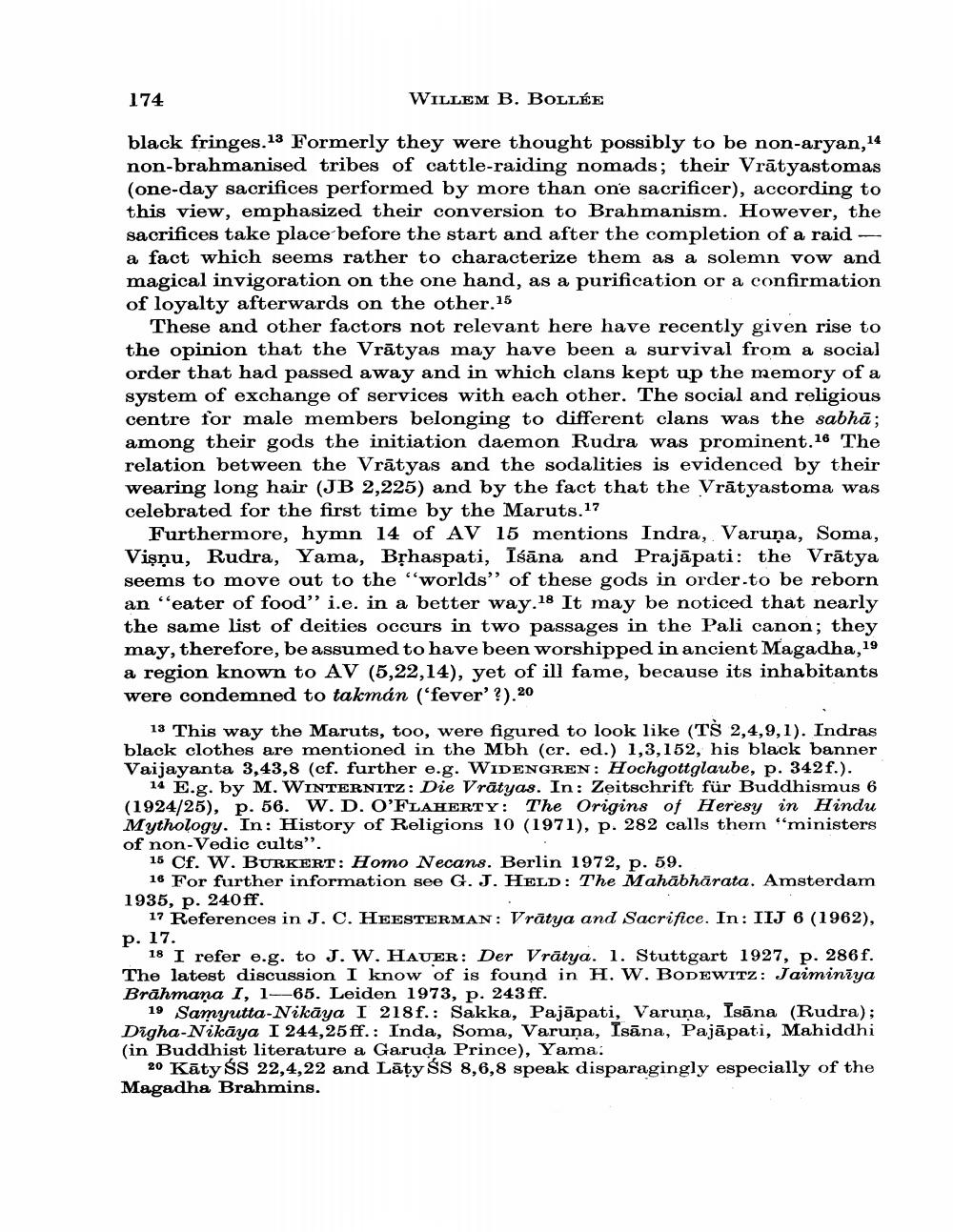________________
174
WILLEM B. BOLLÉE
black fringes.13 Formerly they were thought possibly to be non-aryan, 14 non-brahmanised tribes of cattle-raiding nomads; their Vrātyastomas (one-day sacrifices performed by more than one sacrificer), according to this view, emphasized their conversion to Brahmanism. However, the sacrifices take place before the start and after the completion of a raid - a fact which seems rather to characterize them as a solemn vow and magical invigoration on the one hand, as a purification or a confirmation of loyalty afterwards on the other. 15
These and other factors not relevant here have recently given rise to the opinion that the Vrātyas may have been a survival from a social order that had passed away and in which clans kept up the memory of a system of exchange of services with each other. The social and religious centre for male members belonging to different clans was the sabhā; among their gods the initiation daemon Rudra was prominent.16 The relation between the Vrātyas and the sodalities is evidenced by their wearing long hair (JB 2,225) and by the fact that the Vrātyastoma was celebrated for the first time by the Maruts.17
Furthermore, hymn 14 of AV 15 mentions Indra, Varuņa, Soma, Vişņu, Rudra, Yama, Bșhaspati, Išāna and Prajāpati: the Vrātya seems to move out to the "worlds" of these gods in order to be reborn an "eater of food" i.e. in a better way.18 It may be noticed that nearly the same list of deities occurs in two passages in the Pali canon; they may, therefore, be assumed to have been worshipped in ancient Magadha,19 a region known to AV (5,22,14), yet of ill fame, because its inhabitants were condemned to takmán ('fever'?).20
13 This way the Maruts, too, were figured to look like (TS 2,4,9,1). Indras black clothes are mentioned in the Mbh (cr. ed.) 1,3,152, his black banner Vaijayanta 3,43,8 (cf. further e.g. WIDENGREN: Hochgottglaube, p. 342f.).
14 E.g. by M. WINTERNITZ: Die Vrātyas. In: Zeitschrift für Buddhismus 6 (1924/25), p. 56. W. D. O'FLAHERTY: The Origins of Heresy in Hindu Mythology. In: History of Religions 10 (1971), p. 282 calls them "ministers of non-Vedic cults".
15 Cf. W. BURKERT: Homo Necans. Berlin 1972, p. 59.
16 For further information see G. J. HELD: The Mahābhārata. Amsterdam 1935, p. 240ff.
17 References in J. C. HEESTERMAN: Vrātya and Sacrifice. In: IIJ 6 (1962), p. 17.
18 I refer e.g. to J. W. HAUER: Der Vrātya. 1. Stuttgart 1927, p. 286f. The latest discussion I know of is found in H. W. BODEWITZ: Jaiminiya Brāhmana I, 1–65. Leiden 1973, p. 243 ff.
19 Samyutta-Nikāya I 218f.: Sakka, Pajāpati, Varuņa, Isāna (Rudra); Dĩgha-Nikaga I 244,25ff.: Inda, Soma, Varuna, Isẵna, Pajāpati, Mahiddhi (in Buddhist literature a Garuda Prince), Yama:
20 Kāty SS 22,4,22 and Laty SS 8,6,8 speak disparagingly especially of the Magadha Brahmins.




